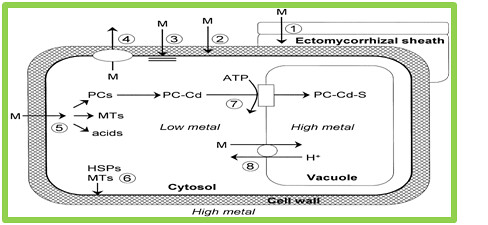Authors: Gajendra Rathod1, Sukumar Taria1, Deepak Pawar2, Mahesh Mahajan2, Rakesh Kumar Prajapat2
1Ph.D scholar, Division of Plant Physiology, IARI, New Delhi-110012
2 Ph.D scholar, NRCPB, IARI, New Delhi-110012
Phytoremediation:
Phytoremediation is the use of green plants and their associated microorganisms to stabilize or reduce contamination in soils.These plants also termed as hyper accumulators, absorb toxic metals into their roots, stems & leaves and help to clean them up from soils.
What is heavy metal?
• A heavy metal is an element with the density of > 4-5 g/cm3 and is hazardous and accumulate in the human body
• It includes Hg, Cd, Pb, Cu, Mn, Zn, Cr, As, Ni, Co and V
• Heavy metal ions of Cd2+, Hg2+, and Pb2+ are nonessential and toxic to plants
• Cu2+, Zn2+, Mn2+, Fe2+ and Ni2+ are essential micronutrients for plants, but toxic when present in high concentration
Sources of heavy metal contamination in soil
• Geological sources of heavy metals: Earth crust volcanic activity
• Anthropogenic Sources: Industrial effluents, fuel production, mining, smelting processes, small-scale industries (battery production, metal products, and cable coating industries), brick kilns, coal combustion, municipal wastages, excess application of (sometimes banned) pesticides, fungicides and fertilisers, Irrigation water contaminated by sewage and industrial effluents etc.
Phytoremediation includes the following processes and mechanisms of contaminant removal
| Sr. No. | Process | Mechanism | Contaminant |
| 1 | Rhizofiltration | Rhizosphere accumulation | Organics/ Inorganics |
| 2 | Phytostabilization | Complexation | Inorganics |
| 3 | Phytoextraction | Hyper-accumulation | Inorganics |
| 4 | Phytovolatilization | Volatilisation | Organics/ Inorganics |
| 5 | Phytotransformation | Degradation in plant | Organics |
Mechanisms of heavy metal sequestration
Metal Uptake Mechanism:
Metal uptake depends primarily on metal bioavailability in soil. The uptake is achieved by mobilizing metals bound to soil particles through the metal-chelating molecules (mugenic and aveic acids) secreted into the rhizosphere, specific plasma-membrane bound metal reductase and the proton extrusion from roots. Plants possess several classes of metal transporters such as heavy metal (or CPX-type) ATPases that are involved in the overall metal-ion homeostasis and tolerance in plants.
Metal Translocation to Shoots
Phytochelatin -mediated metal binding in the xylem sap is a possible mechanism for metal translocation of low molecular weight chelators such as citrate and free histidine (Prezemeck and Haase, 1991). Many gene families that are involved in metal transport are heavy-metal ATPases, natural resistance-associated macrophage proteins (NRAMPs), cation diffusion facilitators, the Zrt- and Irt- like proteins family.
• Phytochelatins : Heavy metal accumulation in plants induces production of phytochelatins (PCs), a family of thiol rich peptides of a general structure (?-Glu-Cys) n-Gly, where n is normally in the range of 2â€"5. Cadmium and Arsenic effectively induce phytochelatin synthesis.
• Metallothioneins: Metallothioneins (MTs) is a group of low molecular weight, cysteine-rich metal binding proteins which provide thiols for metal chelation. Overexpression of genes involved in the synthesis of metal chelators may lead to enhanced or reduced metal uptake and enhanced metal translocation and or sequestration. An MT- gene (CUP1), when overexpressd in cauliflower, resulted in a 16- fold higher Cd tolerance (Hesegawa et al., 1997).
Tolerance Mechanism
• Exclusion: The electrical charge prevents metal ions from diffusing freely across the lipophilic cellular membranes into the cytosol. Ion transport into cells is mediated by membrane proteins with transport functions. Entry of Cadmium in the cells of radish seeds through Ca channels (Rivetta et al., 1997).
• Vacuolar Compartmentalization: Significant for metal detoxification and plant tolerance. This process prevents free concentration of metal ions in the cytosol and forces them into a limited space. High-level expression of a vacuolar metal-ion transporter TgMTP1 in Thlaspi goesingense was proposed to account for the enhanced ability of plants to accumulate metal ions within shoot vacuoles (Kim et al., 2004).
Potential cellular mechanisms available for metal detoxification and tolerance in higher plants
1. Restriction of metal movement to roots by mycorrhizas
2. Binding to cell wall and root exudates
3. Reduced influx across plasma membrane
4. Active efflux into apoplast
5. Chelation in cytosol by various ligands
6. Repair and protection of plasma membrane under stress conditions
7. Transport of PC-Cd complex into the vacuole and
8. Transport and accumulation of metals in vacuole

Hall J L (2002)
Importance and Perspectives of Phytoremediation
All the phytoremediation techniques are very promising in reducing the heavy metal load from the environment.
In environment point of view among all the processes phytovolatilization is of prime significance as it can be used to convert toxic contaminant to non- toxic contaminants and thus decrease the risk of disposal of contaminated plant parts.
Understanding the mechanisms of heavy metal accumulation, tolerance, degradation in plants will help engineer transgenics for phytoremediation.
References:
1. Prezemeck E. and N. U. Haase, (1991) On the binding of mannose, copper and cadmium to peptides of the xylem sap of plant roots. Water Air Soil Pollut., 57, 844-848.
2. Hesegawa, I.; Terada, E.; Sunairi, M.; Wakita, H.; Shinmachi, F.; Noguchi, A.; Nakajima, M.; Yazaki, J. (1997) Genetic improvement of heavy metal tolerance in plants by transfer of the yeast metallothionein gene (CUP1). Plant Soil, 196, 277-281.
3. Rivetta A.; Negrini N.; Cocucci M. (1997) Involvement of Ca2+ - calmodulin in cd2+
Toxicity during the early phases of radish (Raphanus sativus L.) seed germination. Plant Cell Environ., 20: 600-608.
4. Kim D.; Gustin J. L.; Lahner B.; Persans M. W.; Yun D. J.; Salt D. E.(2004) The plant CDF family member TgMTP1 from the Ni/Zn hyperaccumulator Thlaspi goesingense acts to enhance efflux of Zn at the plasma membrane when expressed in Saccharomyces cerevisiae. Plant J., 39 (2):237-51.
5. Hall J. L. (2002) Cellular mechanisms of heavy metal detoxification and tolerance. J. Exp. Bot., 53:1-11.
About Author / Additional Info:
I am PhD Research scholar in Division of Plant Physiology at IARI, New Delhi, INDIA